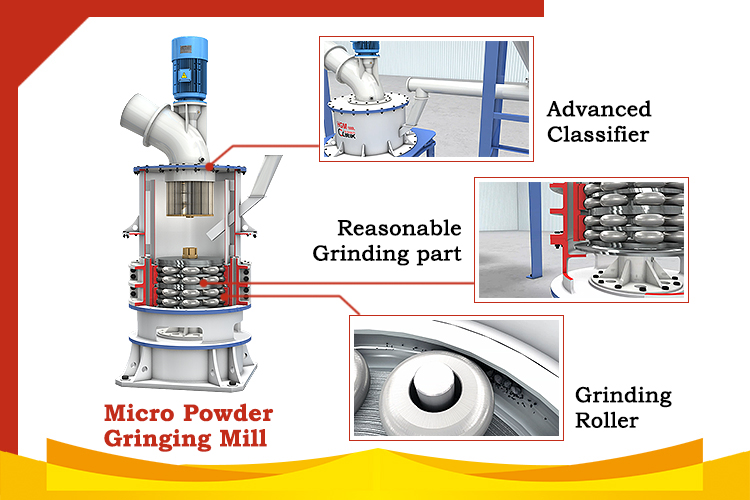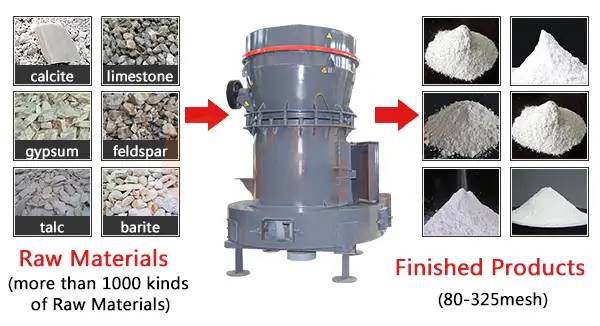Commonly used grinding equipment in the non-metallic ore industry
For non-metallic ore grinding, the selection of processing equipment is very important. Different types of grinding equipment are suitable for minerals with different properties, and have specific correspondence to hardness, raw material particle size, humidity, output, etc. Understanding the working principle, performance characteristics, and scope of application of grinding equipment is the basis for correct selection.
Vertical mill
The vertical mill uses the relative movement of the grinding roller and the grinding disc to crush the material on the material bed. As one of the main developments in the non-metallic ore powder dry ultra-fine processing technology, the vertical mill equipment and technology have been scaled up in the non-metallic mineral industry. And in the practical application of product refinement, the advantages of high efficiency, energy saving and environmental protection have gradually emerged.

Features:
It has a unique energy-saving effect, a single machine has a large capacity, and the processed products have the characteristics of narrow particle size distribution and high purity; the building area of the production line is 30% smaller than that of the ball mill system, and the civil construction cost is lower.
Scope of application:
The vertical mill has been widely used in the production and processing of foreign white non-metallic mineral industry, and it has also been successfully used in the crushing and processing of heavy calcium, barite, limestone, gypsum, pyrophyllite, kaolin, cement raw materials and clinker in China.
Ball mill
Ball mill is a fine grinding equipment commonly used in non-metallic ore grinding. Including grinding for mineral processing preparation, pre-grinding for subsequent ultra-fine grinding and grinding for direct processing of powder products.
Features:
Large crushing ratio, simple structure, standardized product series, easy replacement of wear-resistant parts such as liners, mature technology, reliable operation, etc.; the ball mill can be adapted to different operations, such as grinding and drying, grinding and mixing at the same time, etc. But generally speaking, the powder ore efficiency of the ball mill is not high, the energy consumption and medium consumption are relatively high, and the equipment is heavy and the operation noise is relatively loud.
Scope of application:
Ball mills are still widely used grinding equipment at home and abroad, among which grid type and overflow type ball mills are commonly used grinding equipment for non-metallic ore beneficiation; tube mills include grinding cement raw material mills and grinding various types of cement clinker Cement mills are mainly used in cement plants, and can also be used to grind other materials in relevant industrial sectors. Short tube ball mills are widely used in the fine grinding of calcite, dolomite, quartz, zircon sand and other non-metallic ores.
Raymond mill
Raymond mill, also known as suspension roller disc mill, is mainly composed of feeder, grinding roller, grinding disc, transmission mechanism, separator and other parts. It is an important grinding equipment in the process of non-metallic ore processing.

Features:
It has the advantages of stable performance, simple process, convenient operation, large processing capacity, adjustable product particle size, etc.; high sieve pass rate, and the sieve pass rate of finished products after Raymond mill grinding can reach more than 99%; strong set, whether it is From rough processing of raw materials to transportation, milling and final packaging, it can form an independent production system.
Scope of application:
Widely used in calcite, marble, chalk, limestone, talc, wollastonite, gypsum, hard kaolinite, clay, feldspar, barite, bentonite, graphite, tremolite, illite, sericite, glass, Manganese ore, titanium ore, copper ore, chrome ore, refractory materials, thermal insulation materials, clay, titanium dioxide, iron oxide and other non-flammable and explosive minerals, construction, and chemical industry with Mohs hardness below 9.3 and humidity below 6% High-fine powder processing of more than 300 kinds of materials in industries such as chemical fertilizers, chemical fertilizers, etc. The particle size of the finished product is within the range of 60-325 mesh (0.125mm-0.044mm), and the maximum fineness of a small part of the material can reach 1000 mesh (0.013mm) according to the needs. .
Jet mill
Jet mill is one of the most important ultra-fine crushing equipment, the product fineness can generally reach 1-45μm, and the output ranges from dozens of kilograms to several tons per hour. Using high-pressure air, inert gas or superheated steam to expand and cool down to accelerate to form a high-speed flow field, drive material particles to collide, rub, and shear each other in the jet flow field to achieve material refinement. The common ones are flat type, fluidized bed reverse injection type, circulating pipe type, opposite spray type, target type, etc., with dozens of specifications.
Features:
The product has the characteristics of fine particle size, narrow particle size distribution, smooth particle surface, regular particle shape, high purity, high activity, good dispersion, and low temperature rise in crushing; the disadvantages are high equipment manufacturing costs, large one-time investment, and high energy consumption. Powder processing costs are high.
Scope of application:
Superfine grinding of calcium carbonate, talc, quartz, bentonite, kaolin, graphite, wollastonite, dolomite, serpentine, zircon, mica, barite and other non-metallic minerals.
Mechanical impact ultrafine pulverizer
The mechanical impact ultra-fine pulverizer is the ultra-fine pulverization equipment that is widely used in the domestic non-metallic mineral industry. The product fineness can generally reach d97=10μm, which is the so-called 1250 mesh. It can produce d97 after being equipped with a high-performance fine classifier. =5-7μm ultrafine powder product.
Features:
Advantages: high crushing efficiency, large crushing ratio, easy to adjust the crushing particle size, wide application range, simple structure, stable operation, small footprint for mechanical installation, continuous and closed-circuit crushing, etc., suitable for crushing medium and soft materials .
Disadvantages: There are wear and heating problems, and appropriate measures should be taken for the crushing of heat-sensitive substances.
Scope of application:
Applied to ultra-fine grinding of non-metallic minerals below medium hardness such as coal series kaolin, calcite, marble, chalk, talc, pyrophyllite, mica, graphite, wollastonite, bentonite, diatomite, etc., as well as chemical raw materials, pigments, pesticides, etc. processing.
Stirring ball mill
Stirring ball mill refers to a type of ultra-fine grinding equipment consisting of a stationary cylinder filled with grinding media and a rotating agitator. The product fineness can be as fine as below 1 μm.
Features:
High speed, high medium filling rate and small medium size are adopted to obtain extremely high power density, which greatly shortens the grinding time of fine materials. Large-scale applications have two major problems: small processing volume and high wear and tear costs.
Scope of application:
It is suitable for ultra-fine grinding processing of kaolin, talc, mica, calcium carbonate, wollastonite, zircon sand and other non-metallic minerals, pigments, ceramics, papermaking, coatings, chemical products, etc.
